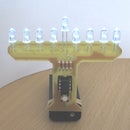Introduction: Beer Bottle Drying Rack
One of the most labor intensive parts of home brewing is the bottling process. Since I have to wait two more days to do the actual bottling I decided to make a tool to simplify the process.
This bottle drying rack was made from leftover scraps (making it effectively a free project) and can hold 72 bottles.
Materials:
1/4" Hardboard
Scrap wood for legs
Step 1: Layout
Here is my scrap sheet of hard-board. I don't know the dimension, I just started by setting some bottles on it to get an idea of the needed spacing. I can 6 to a row putting them 4 inches on center. I used a straight-edge and pencil to draw a grid of layout lines.
Step 2: The Holes
Time to try out the holes.
I drilled a test hole in a piece of scrap wood using a 1 3/4" hole saw. Perfect fit.
Using a fast drill and the hole saw I drilled 72 holes in the hard-board using the layout lines from the previous step.
Step 3: The Legs
Time for the legs.
We're basically building a little L shape to prop the hard-board up off the floor so the bottles can drain (and remain sanitary). For this I use two pieces of scrap wood. The are actually shelves from the IKEA as-is department. 10 cents each and the turned out to be too small for what I purchased them for. This turned out to be an excellent use for them!
I cut each into 5 equal pieces, pre drilled holes, and screwed them together.
Step 4: Assembly
1. Position the legs.
- Flip over the hard-board and place the legs where you want them.
3. Drill a pilot hole through the hard board inside of your pencil marks.
4. Flip the board right-side-up and carefully position the feet exactly withing the pencil marks.
5. Attach each leg with one screw.
- Locate a pilot hole you drilled in step 4.
- Drill down through this hole into the leg.
- Screw the leg and board together using this hole.
- Repeat for each leg, one screw only.
- The single screw should hold the leg in place but allow for fine tuning.
- Once alignement has been verified, drill pilot holes and drive in the remaining screws.
Step 5: Conclusion
This rack works great. Just put some old newspaper underneath it to catch the drips, and use it to dry your bottles without worrying about something falling into an open bottle and contaminating the beer.













